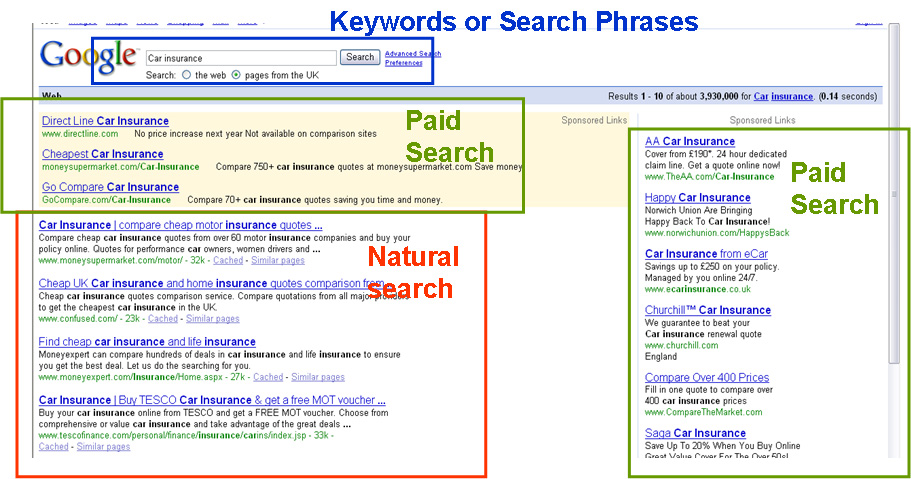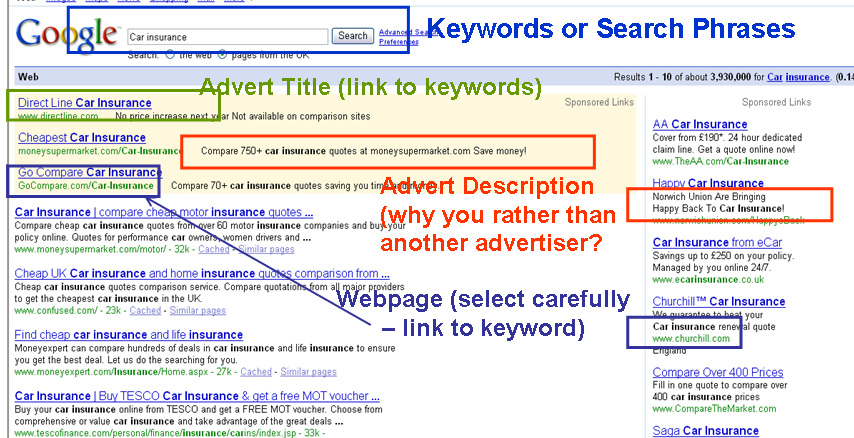Paying your way to the top of Google
Where Search Engine Optimisation (SEO) attempts to get your site to the top of Google naturally, pay-per-click (PPC) means buying an advert higher than the position you would normally achieve. Google calls this service ‘Google Adwords’ or ‘Sponsored Links’, but it also available on other search engines such as Bing, Yahoo and Ask.
The PPC advertising positions are highlighted in the image below:
Pay-per-click can be a useful technique to use in the following situations:
- SEO takes time to have an effect. PPC can plug the gap whilst the micro-business waits for a higher natural search position.
- For a specific buying situation. If a product had been used in a television programme, for example, and you sold the product, you could place a PPC advert highlighting that you sell it.
- Short-term offers. This is the equivalent of a ‘Sale’ sign in a shop window. You could advertise an offer for a limited time then remove it when sufficient sales had been made or the stock had sold out.
- Where the micro-business is unlikely to rank highly for a search term, perhaps because the area was very competitive or there were too many other competitors who already had a high natural ranking.
How Pay-Per-Click Works
PPC operates differently from other types of advertising. If you advertised in a newspaper, for example, you would be a charged a fixed amount for the advert regardless of whether anyone responded or not. With pay-per-click, the advert has a link to your website and you pay only for people that click on the advert and visit your site.
The amount you pay for each click is determined by the search engine and depends on how many other companies want an advert for a given keyword. So if you wanted an advert displayed to people searching for ‘marketing advice’, for example, the cost would be determined by how competitive that phrase was. The more competitive the phrase, the higher the price per click.
You set a budget for how much you are willing to pay for both an individual click and a total daily expenditure. These two factors determine how high your advert will be placed in the rankings. The more you are willing to pay per click and per day, the higher your advert will rank.
So if your maximum budget per month was £1,000 per month and the average cost per click was £2, you would know that your maximum expenditure per month was £1,000 and for that you would get up to 500 visits to your website. Natural SEO could never give you that sort of ‘guarantee’.
Key Pay-per-Click Considerations
There are several elements highlighted in the image below:
Advert Title and Description. As with SEO, the searcher needs to make a decision on which site to visit – the Title and Description are how you communicate the Unique Selling Points of your micro-business and demonstrate why someone should visit your site, rather than a competitor’s. For more details on how you might work out what these key points are, read Unique Selling Points.
Webpage links. This is the page that visitors will go to when they click on your micro-business’s advert. The link should be descriptive of what you sell rather than the full url. So if it was about ‘Marketing Advice for Small businesses’, you would give it that title. Have this link to a ‘landing page’, which is a specific page designed for visitors to your site that don’t come via the Home page.
As far as possible, make the landing page complete with everything that a visitor needs to make the decision on whether to use you or buy from you. The PPC advert might be the first time they have ever heard of your micro-business and they are focused on finding out something specific, so bear that in mind when creating the page. Rather than sending them to various parts of your website, try to reel them in quickly and close the sale.
Managing the Adverts
PPC is very controllable and manageable. Google provides a control panel with everything you need to monitor results including costs per click, average position of the advert and number of click-throughs to the site. It will also display this for each of your adverts so testing for the most effective approach becomes very easy. You can read more about the principles of this in Testing.
Disadvantages of PPC
Pay-per-click can become very expensive, particularly for competitive phrases. Remember also that you are paying for a visit to your website, but they might not buy from you.
If you have multiple phrases then you have to set up and manage each one. So ‘Marketing Advice for Small Businesses’ would be a phrase with its own advert, as would ‘Small Business Marketing Advice’ and ‘Marketing for a Small Business’. It can quickly become a very time-consuming job to manage and control all the different elements.
If you have to set up landing pages and contract someone to manage the adverts then the costs of this will eat into your profits, making it less attractive than it might have appeared at first.
Finally, it doesn’t help with natural search, so unless you also have a program of search engine optimisation running in parallel you will find yourself always having to pay for web site visits, rather than benefiting from natural search.
Whether PPC is a suitable marketing approach for your micro-business will depend on a number of factors. Reading Types of Advertising (PPC is a Proactive type of advertising) and Choosing the Right Media will give you some guidance on the role it could play in your micro-business marketing activity.




